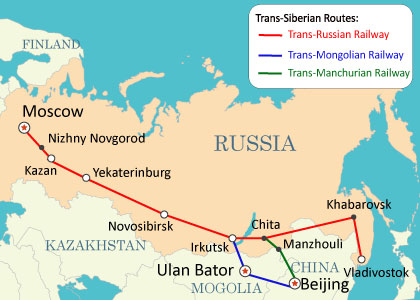Trans-Siberian Railway
Trans-Siberian Railway is the main railway line that stretches across the East and West of Russia, departing from Moscow Yaroslavsky Train Station, running through Kazan, Yekaterinburg, Novosibirsk, Irkutsk, Chita, Khabarovsk (Boli) and finally reaching Vladivostok. With a total length of 9259 km (5753 miles), it can be regarded as the longest railway line in the world. The Trans-Siberian Railway is called the “backbone” of Russia and it is a bridge of Eurasian civilization as well, which has a far-reaching impact on Russia, Europe and Asia’s economies and culture.

|
The Trans-Siberian Railway line refers to the whole journey of Moscow-Vladivostok. While, there are two branches of Trans-Siberian Railway, one is the Trans-Mongolian Railway line which traverses across the Mongolia and goes to Beijing straightly, another is the Trans-Manchurian Railway line which circumvents the Mongolia and finally goes back to Beijing as well. The Trans-Siberian Railway is the most incredible and mysterious rail journey in the world and every single of the branch has its own unique characteristics, attracting a number of travelers each year to experience the marvelous trip by taking the train.
Trans-Russia
The “Trans-Russian” can be considered as the oldest segment of Trans-Siberian Railway, departing from Moscow which is the capital of Russia and reaching Vladivostok in the south-east of Russia. There are plenty of trains running across Russia and the Trans-Siberian network. As is known to all, the transportation in Russia is smooth and developed, including domestic and international train routes.
The “Trans-Russia” goes through the central area of Siberia, passing by many important cities in Russia, like Yekaterinburg, Novosibirsk and Irkutsk, as well as some natural wonders, like Baikal Lake and Ural Mountains. The destination Vladivostok is also a fascinating port city with particular atmosphere where you can take a ship to Japan and South Korea.
You can have a stopover in any destinations to appreciate the amazing scenery by taking the train 002, 001, 100 or 099, which depends on your demands. Different trains may offer different service and have different infrastructures.
Trans-Mongolia
The “Trans-Mongolia”, an offshoot of the Trans-Siberian Railway line, departs from Moscow, passes by Ulaanbaatar which is the central city of Mongolia and finally arrives in Beijing. This railway line traverses across many cities of Siberia, then heading for Beijing. It also stops in some major cities, like Yekaterinburg, Novosibirsk, Irkutsk and Ulaanbaatar, where people always can’t help admiring the breath-taking scenery. It goes through some natural wonders as well, like the Mongolian Steppes and the Gobi desert, which will be an unforgettable experience for every traveler.Train 004 and 003 are running the whole route between Moscow and Beijing passing by Ulaanbaatar. While train 006 and 005 are only operating between Moscow and Ulaanbaatar, which takes about 5 days one way.
|
|
|
Trans-Manchuria
The “Trans-Manchuria” is another branch of the Trans-Siberian Railway, departing from Moscow, splitting off from the Trans-Siberian in Chita, bypassing the area of Mongolia and finally arriving in Beijing. This Railway line also goes through some important cities of Siberia and northeast China, from Manzhouli to Harbin and then to Beijing. Manchuria is a historically interesting area, which opens the first door to travel into China.The train 020 and 019 run for the Trans-Manchurian Railway line weekly. Most travelers think it is less ‘touristy’ than the Trans-Mongolian line and takes longer time, so the train 020/019 is less used than train 004/003. However, the advantage for this railway route is that you only need to apply for one visa to Russia rather than two visas for Russia and Mongolia.

